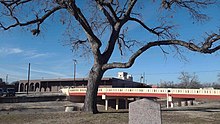Great Hanging at Gainesville
Confederate troops captured and arrested some 150–200 men in and near Cooke County at a time when numerous North Texas citizens opposed the new law on conscription.
The Cooke County Heritage Society planned a formal commemoration in 2012 to mark the 150th anniversary of the Great Hanging.
[5] The arrival in Gainesville of the Butterfield Overland mail route, following a trail surveyed by U.S. Army Captain Randolph B. Marcy in 1849, in 1858, brought a rapid rise in Cooke County's population from 220 people in 1850 to 3,760 in 1860.
The majority of Texans came from the Upper South, but slaveholding Lower Southerners were pre-eminent and disproportionately represented in Texas's government.
The production of cotton, which had exploded over seven-fold in Texas over the 1850s, made enslavers rich and connected the state's leaders to the future Confederacy.
Enslavers also controlled the volunteer state militias and often led them on expeditions against nearby Native Americans raiding Cooke and other North Texas counties.
When a series of fires caused significant damage to North Texas,[b] tensions flared and then exploded into violence that resulted in three slaves hanged in Dallas, a Methodist minister by the name of Anthony Bewley lynched,[11] a hundred others whipped, and many free Northern Texans who had not already murdered or chased out of Texas by vigilantes.
Despite growing secessionism in Texas, Cooke County increasingly cast its lot against the incumbent Southern Democrats.
Nearby U.S. Army forts, which did business with North Texan enslavers, protected against Native American raids.
As in the rest of the antebellum South, however, John Brown's raid on Harpers Ferry and the election of Abraham Lincoln as President of the United States eliminated backlash against secession in Texas.
The January 1861 session of the Texas Legislature overwhelmingly voted in favor of secession, to which Throckmorton was a leading opponent.
This exodus gave Confederate officials and supporters the false belief that opposition to secession in North Texas had "vanished", as was reported in The Times-Picayune, in New Orleans.
War taxes — in effect a year before they were law in the Confederacy — and impressment of local firearms and men were hated, but the most offensive was conscription, passed on 16 April 1862.
[14] In April, 30 men of Cooke County formed a Union League and signed a petition to Richmond objecting to the government's policy of exempting large enslavers from the draft.
[15] Area enslavers claimed to fear that the group was colluding with pro-U.S. forces from out of state and notified local authorities about the incidents.
On the morning of 1 October 1862, state troops led by the local provost, Colonel James G. Bourland, began arresting suspected Unionists in the area.
Bourland and Young together had reason to want to suppress dissent, as they owned about one-quarter[17][18] of all enslaved people in the county.
President Jefferson Davis remained silent, having already dismissed General Paul Octave Hébert on 10 October as military commander of Texas for his imposition of martial law and harsh measures in enforcing conscription.
[18][25] Davis felt Hébert did not sufficiently control local commanders and provosts and had allowed military atrocities to take place.
[24] Troubles continued in North Texas, though, with hundreds of families fleeing the state to escape the violence and chaos.
It claims the "Peace Party" had "sworn to destroy their government, kill their leaders, and bring in federal troops."
That year, the Cooke County Heritage Society planned an October event in Gainesville to mark the 150th anniversary of the Great Hanging as part of Civil War history.
"[26] Colleen Carri, a heritage society board member, combined the commemoration with the annual Clark family reunion planned for 13 October.
[26] He wrote Tainted Breeze: The Great Hanging at Gainesville, Texas 1862 (1994), considered the "first comprehensive study" of this event.
[17] At the same time, members of the local chapter of Sons of Confederate Veterans, who include some descendants of hanged men, had created a video, Black October 1862.


